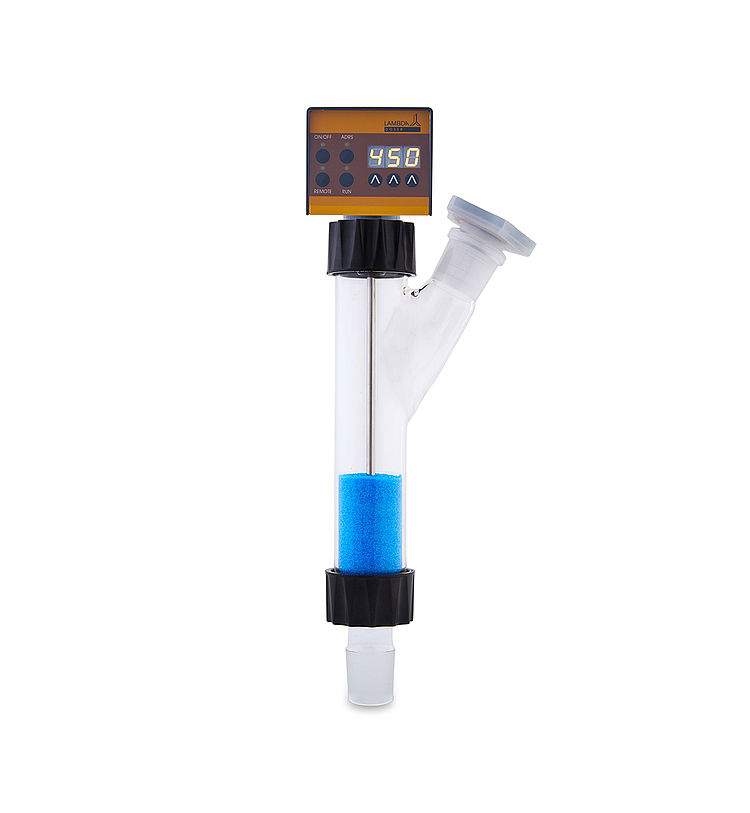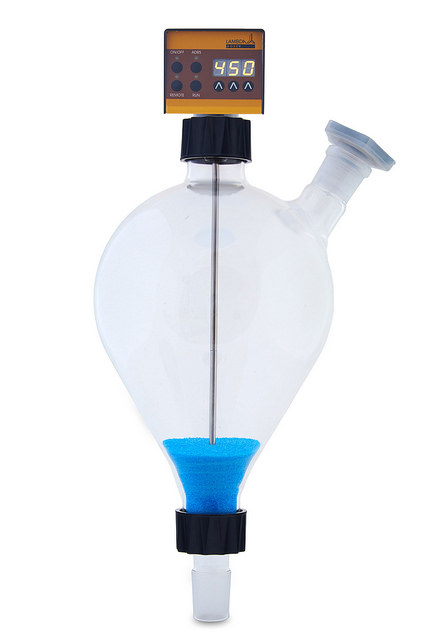Pulverdosierer für das Labor
Pulverdosierer für das Labor
LAMBDA DOSER und LAMBDA Hi-DOSER sind einzigartige, programmierbare Pulverdosierer für die kontinuierliche Dosierung oder Portionierung von rieselfähigen Feststoffen im Labor.
LAMBDA DOSER und Hi-DOSER Pulverdosierer ermöglichen die automatische und kontinuierliche Zugabe von rieselfähigem Pulver, pulverartigen und kristallinen Feststoffen. Im Weiteren werden die Pulverdosierer mit dem optionalen Fussschalter zur Pulverportionierung im Screening und in der Medienvorbereitung eingesetzt.
LAMBDA DOSER / Hi-DOSER Pulverdosierer modernisieren Ihr Labor
Modernisieren Sie Ihr Labor, indem Sie rieselfähige Pulver wie pulverförmige Gefahrenstoffe sicher und automatisch dosieren:
Der moderne Pulverdosierer LAMBDA DOSER / Hi-DOSER besteht aus einer Dosiereinheit mit einem Schrittmotor, der digital durch modernste Elektronik angesteuert wird. Damit ermöglichen LAMBDA DOSER und Hi-DOSER eine konstante und reproduzierbare Dosierung der pulverförmigen Feststoffe.
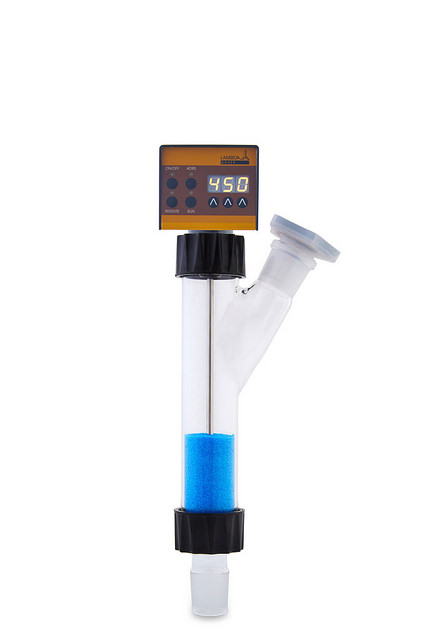 |
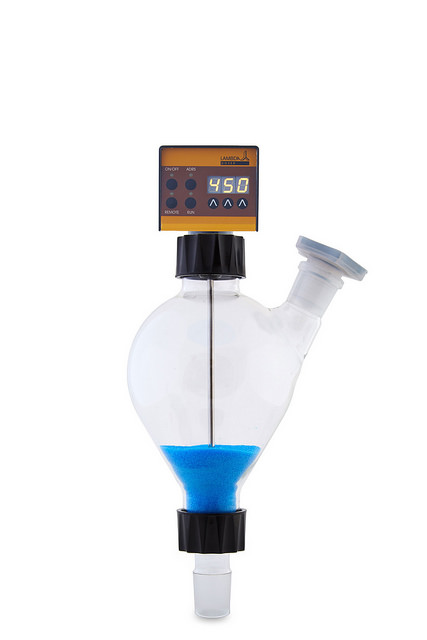 |
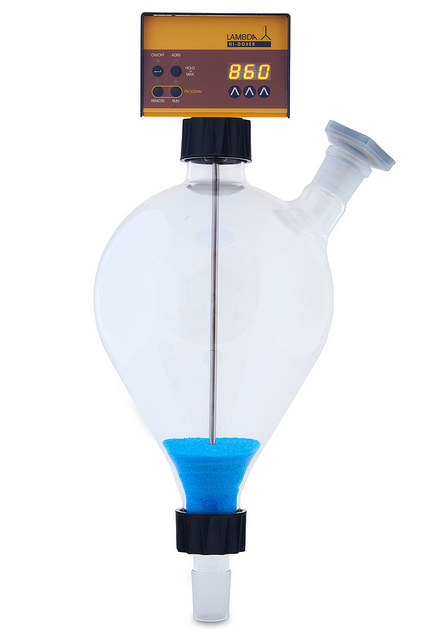 |
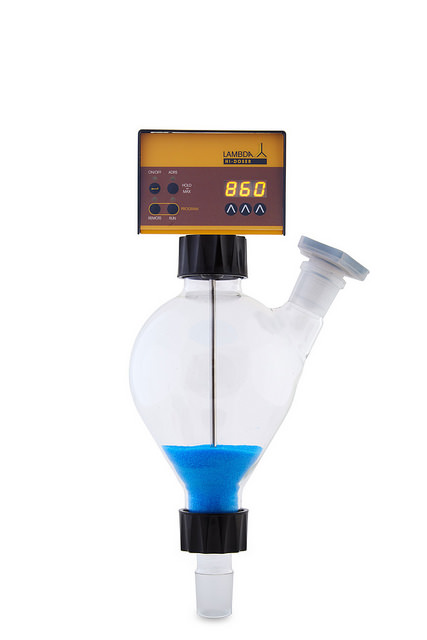 |
 |
| DOSER 0.2L | DOSER 1L | DOSER 3L | Hi-DOSER 1L | Hi-DOSER 3L |
Die Bilderstrecke zu Pulverdosierer und Einzelteile finden Sie auf www.lambda-instruments.com/de/pulverdosierer/doser-hidoser-bilderstrecke/ .
Pulverdosierer mit hervorragenden Eigenschaften
Nebst der digitalen Einstellung und der Programmierung am Pulverdosiergerät, bieten LAMBDA DOSER / Hi-DOSER Pulverdosierer auch einen Fussschalter an.
Dank den analogen und digitalen Fernsteuerungsmöglichkeiten lassen sich die Pulverdosierer auch für automatisch kontrollierte Prozesse einsetzen bzw. sich in Ihr Prozessleitsystem (PLS) einbinden.
Dosiergeschwindigkeit des Pulverdosierers
Die Dosiergeschwindigkeit lässt sich direkt am Display des Pulverdosierers oder ferngesteuert zwischen 0 und 999 digital einstellen.
Die Dosiergeschwindigkeit ist unter anderem von den Pulvereigenschaften abhängig. Beispiel der Dosierung von NaCl unter LAMBDA Laborbedingungen:
- LAMBDA DOSER: 50 mg/min bis 50 g / min NaCl
- LAMBDA Hi-DOSER, slow mode: 60 mg/min bis 60 g/min
- LAMBDA Hi-DOSER, fast mode: 250 mg/min bis 250 g/min
Fernsteuerung der Pulverdosierung
Die Fernsteuerung der Zugabegeschwindigkeit bei der Pulverdosierung ist über den gesamten Bereich möglich und erfolgt durch die Verwendung einer Spannung zwischen 0 und 10 V.
Ein- und Ausschalten (ON/OFF) wird durch externen Kontakt oder ein 12 V Signal erreicht.
Die RS-485 oder RS-232 Schnittstelle (optional) ermöglicht eine erweiterte Steuerung ab PC / Laptop (variable Durchflüsse, Dosiergradienten, usw.).
Die Einzelheiten zu den Anschlüssen finden Sie in der Bedienungsanleitung der LAMBDA DOSER / Hi-DOSER Bedienungsanleitung
Datenspeicherung und Visualisierung
Die PC-Software PNet ist die ideal für die Fernsteuerung der Dosiereinheiten, Datenspeicherung und Visualisierung der Pulverdosierung.
Sie können bis zu 6 Pulverdosierer per RS-485 Schnittstelle und Kabel an einen USB oder seriellen Port Ihres Computers anschliessen, ohne dass Sie weitere Software-Lizenzen für die zusätzlichen Laborgeräte erwerben müssen.
Das real-time Diagramm von PNet dient vor allem der vereinfachten Prozessüberwachung während Fermentationen im Laborfermenter. Zudem sind alle Dosierdaten für den elektronischen Batchrecord auf Ihrem PC speicherbar. Das Datenarchiv von PNet kann zudem in geläufige Programme für Berichte und Tabellenkalkulation eingelesen werden.
Volumen der Vorratsgefässe für die Dosiervorlage
Für die Pulverdosierer LAMBDA DOSER / Hi-DOSER sind folgende Vorratsgefässe für das Dosiervorlage erhältlich:
- 0.2L Glasgefäss
entspricht ~200 ml Volumen für 250 g NaCl, 200 g NaHCO3, 150 g Saccharose.
Das 0.2L Vorratsgefäss ist für die meisten Laboranwendungen mit LAMBDA DOSER das optimale Volumen für die Pulvervorlage. - 1L Glasgefäss entspricht ~1 Liter
- 3L Glasgefäss entspricht ~3 Liter
Die Vorratsgefässe für die Pulvervorlage sind austauschbar.
Für grössere Volumenvorlagen kann das Vorratsgefäss über den Seitenstutzen neu mit Pulver befüllt werden.
Sicherheit bei der Pulverdosierung im Labor
Die Pulverdosierer LAMBDA DOSER und LAMBDA Hi-DOSER erlauben eine reproduzierbare, sichere und mit der Laborsicherheit konforme Pulverdosierung von pulverförmigen Gefahrenstoffen. Zum Schutz des Laborpersonals ist das Pulverdosiergerät auch fernsteuerbar.
Die hermetische Bauart des DOSER Pulverdosiergeräts erlaubt die sichere Handhabung von gefährlichen und toxischen Feststoffen im Labor.
Falls die Pulvervorlage vor Verklumpungen oder Reaktionen mit der Luftfeuchtigkeit zu schützen ist, kann das vorgelegte Pulver im Vorratsbehälter durch einen speziellen Aufsatz auch mit Inertgas oder getrockneter Luft umspült werden.
Falls wegen Bruchgefahr der Prozess vor Glassplittern zu schützen ist, können Sie die Glasgefässe für die Pulvervorlage auch mit einer Silikonbeschichtung (aussen) bestellen.
Alle Teile, die dem Dosiergut ausgesetzt sind, bestehen aus chemisch resistentem Material.
Qualitätsstandard für die Pulverdosierung
LAMBDA DOSER / Hi-DOSER sind ausgezeichnete Pulverdosierer für die Pulverdosierung für den hohen Qualitätsstandard im Labor.
Nebst der digitalen Einstellung und dem präzisen Dosiermechanismus, ist auch die automatische Aufzeichnung der Dosierdaten ausgezeichnet für die Pulverdosierung unter GMP und GLP.
Ein schnell und einfach einsatzbereites Laborgerät!
Die Pulverdosierer LAMBDA DOSER / Hi-DOSER sind gezielt für eine einfache Reinigung und Montage konstruiert. Das Laborgerät ist somit schnell einsatzbereit:
Montage auf die Laborapparatur: einfach per Normschliff
LAMBDA DOSER / Hi-DOSER kann an alle Glasapparaturen mit einem genormten NS 29/32 Stutzen oder Gewindeanschluss SVL angeschlossen werden.
Spezielle Aufmerksamkeit wurde der Minimalisierung der Gerätegrösse bei der Anwendung auf Laborapparaturen geschenkt. DOSER 0.2L kann deshalb einfach an komplexe Laborinstallationen angeschlossen werden.
Die robuste Bauart und die Verwendung von qualitativ hoch stehenden Werkstoffen garantieren die lange Lebensdauer der Pulverdosierer.
Ökonomische Pulverdosierung
Die automatisierte Zugabe von pulverförmigen Feststoffen schafft Laborangestellten kostbare Zeit für andere Aufgaben. Aufgrund der besseren Reproduzierbarkeit und der Elimination von Fehlern kann die Zahl der Experimente reduziert werden.
LAMBDA DOSER und LAMBDA Hi-DOSER Dosiergeräte bietet ein ausgezeichnetes Preis-Leistungsverhältnis.
Programmierung: DOSER: Bis zu 27 Programmschritte bestehend aus Geschwindigkeit und Zeit; Hi-DOSER: Bis zu 99 Programmschritte bestehend aus Geschwindigkeit und Zeit.
Zeitauflösung: 0 bis 999 Minuten in 1 Minute-Schritten oder 0 bis 99.9 Minuten in 0.1 Minute-Schritten: Individuelle Zeitauflösung für jeden Programmschritt.
Motor: DOSER: Mikroprozessorgesteuerter Schrittmotor; Hi-DOSER: Mikroprozessorgesteuerter, bürstenloser, langlebiger BLDC-Motor mit Neodym-Magneten
Geschwindigkeitsbereich: 0 bis 999
Schnittstelle: RS-485 oder Option RS-232
Stromversorgung / Speisung: 95-240 V / 50-60 Hz Wechselstrom-Stecker-Netzteil mit DC 12V / 50W-Ausgang (EU, CH, UK, US, AU); Optionaler Batteriebetrieb für Feldversuche auf 12V Akku.
Volumen: Approx. 0.2 L, 1 L and 3 L glass vessels
Abmessungen: DOSER Motoreneinheit : 6 (H) x 7 (B) x 13 (T) cm; Hi-DOSER Motoreneinheit : 9.5 (H) x 10.5 (B) x 13 (T) cm. Glasgefäss 0.2L: 30 (H) x 12 (B) x 5 (T) cm Glasgefäss 1L: 30 (H) x 18 (B) x 14 (T) cm Glasgefäss 3L: 38 (H) x 21 (B) x 17.5 (T) cm.
Sicherheit: CE, erfüllt die 1010/1 IEC Norm für Laborgeräte.
Betriebstemperatur: 0 - 40 °C
Betriebsfeuchtigkeit: 0 - 90 % relative Luftfeuchtigkeit, nicht kondensierend
Fernsteuerung: 0-10 V DC Dosiergeschwindigkeitsregelung; 3 - 12 V DC EIN/AUS Regelung; Option 0-20 oder 4-20 mA); Option Fussschalter
Software: Option: PNet PC-Software
- DE - Pulverdosiergerät LAMBDA DOSER und HI-DOSER - Prospekt (pdf)
- DE - Bedienungsanleitung - LAMBDA DOSER Pulverdosiergerät (pdf)
- ES - Dosificador de solidos LAMBDA DOSER / HI-DOSER (pdf)
- ES - Instrucciones de uso - Dosificadora de sólidos y sustancias pulverulentas LAMBDA DOSER (pdf)
- RU - Дозаторы порошков LAMBDA DOSER и HI-DOSER - Листовка (pdf)
- RU - Руководство по эксплуатации - Дозаторы порошка LAMBDA DOSER и HI-DOSER (pdf)
- FR - Mode d'emploi - LAMBDA DOSER doseur de poudres programmable (pdf)
- FR - LAMBDA DOSER / HI-DOSER doseur de poudres programmable - brochure (pdf)
- CZ - Návod k obsluze - Dávkovač pevných, krystalických látek a prášků LAMBDA DOSER (pdf)
- CZ - Automatický dávkovač pevných, krystalických látek a prášků LAMBDA DOSER (pdf)
- EN - LAMBDA DOSER and HI-DOSER powder dosing instrument - Leaflet (pdf)
- EN - Operation manual - LAMBDA DOSER and HI-DOSER powder dosing instrument (pdf)
- EN - Application note - LAMBDA powder DOSER - Reproducible powder dosing (pdf)
2024
Wärmebehandelter Nasssilika-Feststoff wurde in den LAMBDA Feststoff-DOSER geladen und dem Reaktor hinzugefügt.
Luo, L., Rix, F. C., Stevens, K. A., Kuo, C. L., Zhang, X., Lovell, J. A., Harlan, C.J., Ye, X., & Berg, B. R. (2024). Improved In-Situ MAO Derived Silica Supported Single-Site Metallocene Catalysts. U.S. Patent Application No. 18/253,867.
https://patents.google.com/patent/US20240092947A1/en (2024 June 17)
„Flash Pyrolyse“ Experimente: Die pulverförmige Biomasse (Mischung aus Zellulose, Hemizellulose, Lignin und Asche) wurde mit einer Geschwindigkeit zwischen 1 und 20 g/mn mit einem LAMBDA Hi-DOSER Pulverdosierer in die Stickstofflinie im Venturirohr eingespeist.
Proust, C., Proust, M., & Foyer, J. (2024, February). High temperature pyrolysis of lignocellulosic biomass for biogas production. In Technological Systems, Sustainability and Safety.
https://hal.science/hal-04538203 (2024 May 14)
Studien zur Feststofftrennung: Der Feststoffspender oben auf dem Wirbelschichtreaktor war ein LAMBDA DOSER 3L, der kontinuierlich Feststoffe mit einer Geschwindigkeit von bis zu 13.7 g/min zuführte.
Ciércoles, R., Lasobras, J., Soler, J., Herguido, J., & Menéndez, M. (2024). A Preliminary Assessment of Sorption Enhanced Methanol Synthesis in a Fluidized Bed Reactor with Selective Addition/Removal of the Sorbent. Removal of the Sorbent.
https://dx.doi.org/10.2139/ssrn.4735903
Vor Beginn der Pyrolyse wurden 6 g Materialien gleichmässig gemischt und in die Zufuhrvorrichtung LAMBDA DOSER 0.2 L gegeben
Wang, X., Peng, Y., Zhou, R., Fan, L., Zhang, Q., Cui, X., Wu, Q., Zeng, W., Tian, X., Ke, L., Ruan, R., & Wang, Y. (2024). Production of monocyclic aromatic hydrocarbons from microwave co-pyrolysis of polyethylene terephthalate and low-density polyethylene using coconut husk carbon as microwave absorbent. Chemical Engineering Journal, 150732.
https://doi.org/10.1016/j.cej.2024.150732
Studie über die Bedeutung der Rohstoffeigenschaften (Feuchtigkeit, flüchtige Bestandteile, fester Kohlenstoff und Aschegehalt) während der Partikelzuführungsphase für die Fallstromvergasung von Biomasseabfällen: Für die Partikelzuführung (Dattelpalmenabfälle, Oliventrester, Klärschlamm) wurde eine Lambda Pulverdosieranlage (LAMBDA DOSER 0.2L) verwendet und der Vergaserdurchfluss, die Nennleistung und die Lagerzeit getestet.
Khan, S., Adeyemi, I., Moustakas, K., & Janajreh, I. (2024). Investigating the characteristics of biomass wastes via particle feeder in downdraft gasifier. Environmental Research, 118597.
https://doi.org/10.1016/j.envres.2024.118597
2023
Die automatische Dosieranlage LAMBDA DOSER wurde verwendet, um kontinuierlich 70 – 80 % des Al2O3 zuzuführen, das für eine theoretische Stromausbeute von 100 % erforderlich ist. Die Systemgrenzen aufgrund kritischer Verstopfungen im Aluminiumoxid-Zufuhrkanal wurden teilweise bereits nach 6 bis 10 Stunden erreicht.
Singh, K., Gunnarsson, G., Magnusson, J. H., Haarberg, G. M., & Saevarsdottir, G. (2023). Performance Evaluation of Low-Temperature KF-NaF-AlF3 Electrolytes for Aluminum Electrolysis Using Vertical Inert Cu–Ni–Fe Alloy Anodes. Journal of The Electrochemical Society, 170(11), 113507.
https://doi.org/10.1149/1945-7111/ad0bae
Lithium-Ionen-Batterien: Dosierung von pulverförmigem Präkursor (Silizium [Si] & Ferrocen [Fe(C5H5)2]; 1 g/min) in eine SWS (surface wave sustained) Plasmasäule (Kerntemperatur >4000K).
Jie, Z., Zhang, Z., Bai, X., Ma, W., Zhao, X., Chen, Q. & Zhang, G. (2023). Surface-wave-sustained plasma synthesis of graphene@Fe–Si nanoparticles for lithium-ion battery anodes. Appl. Phys. Lett. 11 September 2023; 123 (11): 113902.
https://doi.org/10.1063/5.0159269
2022
Die Probe des HDPE Granulats wurde in das Glasvorratsgefäss des Granulatdosierer (LAMBDA DOSER 1 L) vorgegeben.
Dai, L., Zhou, N., Lv, Y., Cobb, K., Chen, P., Wang, Y., Liu, Y., Zou, R., Lei, H., Mohamed, B. A., Ruan, R., & Cheng, Y. (2022). Catalytic reforming of polyethylene pyrolysis vapors to naphtha range hydrocarbons with low aromatic content over a high silica ZSM-5 zeolite. Science of The Total Environment, 847, 157658.
https://doi.org/10.1016/j.scitotenv.2022.157658
Versuchskanal zur Abscheidung magnetischer Partikel: Im ersten Schritt wurde die Flugasche mit einem LAMBDA Dosiersystem mit 1L Behälter (montiert über einem Tablett in der Mitte des Kanalquerschnitts) in den horizontalen Kanal dosiert und dort mit Druckluft (3 bar) aus einer Flachdüse über das Tablett verteilt (siehe Abb. 1 der Publikation).
Czech, T. (2022). Morphology and chemical composition of magnetic particles separated from coal fly ash. Materials, 15(2), 528.
https://doi.org/10.3390/ma15020528
Pulverdosierung von Al2O3 und weiteren getrockneten gesiebten Partikeln in einem Closed-Loop-Aerosolgenerator: Die Partikel wurden mit einem volumetrischen Pulverdosierer LAMBDA DOSER 0.2L in ein 1⁄4” T-Stück dosiert, von wo das Pulver vom Druckluftstrom (5 L/min) aufgenommen und als Aerosol durch den Anlagenstrom geführt wurden.
Prüfert, C., Beitz, T., Reich, O. & Löhmannsröben, H.-G. (2022). Inline process analysis of copper-bearing aerosols using laser-induced breakdown spectroscopy, laser-induced incandescence and optical imaging. Spectrochimica Acta Part B: Atomic Spectroscopy 197 (2022) 106527.
https://doi.org/10.1016/j.sab.2022.106527
Der Feststoffdosierer LAMBDA Hi-DOSER hat eine hervorragende Leistung zur kontinuierlichen Dosierung von Kohlepartikel (1.0 – 1.5 g/min) in der Machbarkeitsstudie für die solarbetriebene hydrothermische Kohlevergasung erbracht.
Dai, T., Xu, C., Zhang, Q., Liu, X., Chang, Z. & Yang, Y. (2022). Experimental study of the solar-driven steam gasification of coal in an improved updraft combined drop-tube and fixed-bed reactor. Energy Conversion and Management, Volume 259,2022,115571,ISSN 0196-8904.
https://doi.org/10.1016/j.enconman.2022.115571
Die integrale Auflösungswärme der Säure-Base-Neutralisationen wurde im Rührreaktor mit dem Reaktionskalorimeter (RC1e, Mettler Toledo Ltd.) gemessen, wobei LAMBDA DOSER kontinuirlich Säure oder Base als Feststoffe zudosierte: 23.6 g/min Citronensäure; 30 g/min NaOH; 21 g/min NaOH; 14.8 g/min NaOH; 7.2 g/min NaOH.
Ran, Z., Ni, L., Pan, Y., Chen, Y., Wang, J., Jiang, J. & Shu, C-M. (2022). Safety Criteria for Solid–Liquid Heterogeneous Systems in Semibatch Reactors. ACS Omega 2022 7 (24), 21207-21219
https://doi.org/10.1021/acsomega.2c02139
Die Einstellung der Eisenerzbeschickungsrate erfolgt direkt über das Pulverdosiergerät.
Zarl, M. A., Ernst, D., Cejka, J., & Schenk, J. (2022). A New Methodological Approach to the Characterization of Optimal Charging Rates at the Hydrogen Plasma Smelting Reduction Process Part 1: Method. Materials, 15(14), 4767.
https://doi.org/10.3390/ma15144767
Dosierung von Carajas-Eisenerz
Ernst, D., Zarl, M. A., Cejka, J., & Schenk, J. (2022). A New Methodological Approach on the Characterization of Optimal Charging Rates at the Hydrogen Plasma Smelting Reduction Process Part 2: Results. Materials, 15(12), 4065.
https://doi.org/10.3390/ma15124065
Versuchsaufbau zur katalytischen Pyrolyse: Das progrogrammierbare Feststoffdosiergerät LAMBDA DOSER 1L dosierte Kunststoffpellets (120 g/h) in einen Reaktor mit Siliciumcarbid-Kugelbett (500 °C).
Zhou, N., Dai, L., Lyu, Y., Wang, Y., Li, H., Cobb, K., Chen, P., Lei, H. & Ruan, R. (2022). A structured catalyst of ZSM-5/SiC foam for chemical recycling of waste plastics via catalytic pyrolysis. Chemical Engineering Journal, Volume 440, 2022, 135836, ISSN 1385-8947.
https://doi.org/10.1016/j.cej.2022.135836
2021
Feststoffdosierung in der halbkontinuierlichen Reaktionskristallisationsstudie: Der Feststoff wurde mit einem LAMBDA DOSER 0.2L dosiert und ein langsamer Druckluftstrom wurde durch den Feststoffdosierer geleitet. Für die Dosierung wurden drei Feststoffe verwendet: CL-20 (150 μm), feines HMX (5 μm) und grobes HMX (300 μm). Durch Mischen des verwendeten HMX grob zu fein im Verhältnis 5:1 wurde eine reproduzierbare Dosierung erreicht.
Herrmannsdörfer, D., & Klapötke, T. M. (2021). Semibatch reaction crystallization for scaled-up production of high-quality CL-20/HMX cocrystal: efficient because of solid dosing. Crystal growth & design, 21(3), 1708-1717.
https://doi.org/10.1021/acs.cgd.0c01611
Feststoffdosierung: Eine Mischung aus 90 g CL-20 (205 mmol), 25 g grobem HMX (84 mmol) und 5 g feinem HMX (17 mmol) wurde mit einem LAMBDA DOSER 0.2L dosiert. Ein langsamer Druckluftstrom wurde durch den Feststoffdosierer geleitet, um eine Zementierung des Feststoffs aufgrund von Acetonitrildämpfen zu verhindern.
Herrmannsdörfer, D., & Klapötke, T. M. (2021). Quality Assessment of the CL‐20/HMX Cocrystal Utilising Digital Image Processing. Propellants, Explosives, Pyrotechnics, 46(4), 522-529.
https://doi.org/10.1002/prep.202000341
Versuchsaufbau zur NOx-Umwandlung, bestehend aus einem vertikal mitgeführten Reaktor und Gasüberwachungssystemen: Ein kalibrierter elektronischer Pulverdosierer (Lambda Laboratory Instruments) führt den recycelten Kunststoff (kryogen pulverisiert, 150 – 355 μm) mit einer konstant niedrigen Zufuhrrate von 7 mg/min durch eine wassergekühlte Sonde in einen Quarzreaktor, der in einem elektrisch beheizten Dreizonenofen untergebracht ist.
Oluwoye, I., Zeng, Z., Mosallanejad, S., Altarawneh, M., Gore, J., & Dlugogorski, B. Z. (2021). Controlling NOx emission from boilers using waste polyethylene as reburning fuel. Chemical Engineering Journal, 411, 128427.
https://doi.org/10.1016/j.cej.2021.128427
Eisenerz- und Kalkzuführsystem: Die kontinuierliche Chargierung erfolgt mittels eines Pulverzufuhrsystems LAMBDA DOSER 0.2L. Das für die Versuche genutzte Feinsterz mit stark adhäsiven Eigenschaften neigte zudem stark zur Brückenbildung, was durch Vorheizen im Trockenschrank bei 120 °C teilweise vermindert wurde.
Cejka, J. (2021). Parameterevaluierung für den kontinuierlichen Chargiervorgang von Eisenerzen und Zuschlägen im Wasserstoff-Plasma-Schmelzreduktionsprozess. Masterarbeit, Montan Universität Loeben.
https://pureadmin.unileoben.ac.at/ws/files/7814331/AC16360490.pdf (2024 April 02)
Löslichkeitsbestimmung von Itaconsäure dosiert mit einem vom PLS angesteuerten Feststoffdosierer LAMBDA DOSER 0.2L
Holtz, A., Görtz, J., Kocks, C., Junker, M., & Jupke, A. (2021). Automated measurement of pH-dependent solid-liquid equilibria of itaconic acid and protocatechuic acid. Fluid Phase Equilibria, 532, 112893.
https://doi.org/10.1016/j.fluid.2020.112893
2020
Plasmaherstellung von Nanomaterialien: Pulverförmige Vorläufer werden mit einem schwerkraftgespeisten rotierenden Pulverdosierer LAMBDA DOSER eingebracht, der an den Einlass des Arbeitsrohrs angeschlossen ist.
Graves, B., Engelke, S., Jo, C., Baldovi, H. G., De la Verpilliere, J., De Volder, M., & Boies, A. (2020). Plasma production of nanomaterials for energy storage: continuous gas-phase synthesis of metal oxide CNT materials via a microwave plasma. Nanoscale, 12(8), 5196-5208.
https://doi.org/10.1039/C9NR08886E
https://www.rsc.org/suppdata/c9/nr/c9nr08886e/c9nr08886e1.pdf (2024 April 02)
Scale-up des Dakin-West-Verfahrens mit Glutaminsäure im 100-Gramm-Massstab, durchgeführt in einem automatisierten Aufbau mit einem LAMBDA Feststoffdosierer
Würdemann, M. A., Niţu, C., De Wildeman, S. M., Bernaerts, K. V., & Orru, R. V. (2020). The Forgotten Pyrazines: Exploring the Dakin–West Reaction. Chemistry–A European Journal, 26(36), 8090-8100.
https://doi.org/10.1002/chem.202000475
Zufuhrsystem für Eisenerz und Kalk: Das Pulverdosiergerät LAMBDA Hi-DOSER 1L, hergestellt von LAMBDA Laboratory Instruments, wurde verwendet, um die Mischung aus Eisenerz und feinen Zusatzstoffen während der Testläufe kontinuierlich in den Stahltiegel zu füllen.
Naseri Seftejani, M. (2020). Reduction of hematite using hydrogen plasma smelting reduction (Doctoral Thesis, Montanuniversitaet Leoben).
https://pure.unileoben.ac.at/en/publications/reduction-of-hematite-using-hydrogen-plasma-smelting-reduction (2024 Feb. 26)
HPSR-Versuchsanlage für die Wasserstoff-Plasma-Schmelzreduktion: Das Pulverdosiersystem LAMBDA Hi-DOSER 0.2L wurde verwendet, um kontinuierlich ca. 3 g/min Carajas Hämatit-Eisenerz mit dem Gas (40 % Wasserstoff in Argon) durch den Hohlraum der Graphitelektrode (HGE, Innendurchmesser 5 mm) einzuführen.
Zarl, M. A., Farkas, M. A., & Schenk, J. (2020). A study on the stability fields of arc plasma in the HPSR process. Metals, 10(10), 1394.
https://doi.org/10.3390/met10101394
Untersuchung des Hydropyrolyseverhaltens von pulverisierter bituminöser Kohle im Fallrohrofen mit einer Temperatur von 800 – 1000 °C: Der Pulverdosierer LAMBDA DOSER zur gleichmässigen, kontinuierlichen Zuführung von 0.6 – 0.7 g/min pulverisierter Kohle wurde oben auf dem DTF Fallrohrofen platziert.
Gao, R., Dou, B., Chang, Q., Xu, J., Dai, Z., Yu, G., & Wang, F. (2020). Effect of temperature and hydrogen on product distribution and evolution of char structure during pyrolysis of bituminous coal in a drop tube furnace. Shanghai Engineering Research Center of Coal Gasification, East China University of Science and Technology, Shanghai 200237, PR China.
https://doi.org/10.1016/j.fuel.2020.117078
Kontinuierlich Einspeisung von 80 g Gemisch aus Eisenerz und Kalk in 1380 Sekunden mit dem Pulverdosiersystem LAMBDA Hi-DOSER 1L
Seftejani, M. N., Schenk, J., Spreitzer, D., & Zarl, M. A. (2020). Slag Formation during Reduction of Iron Oxide Using Hydrogen Plasma Smelting Reduction. Materials 2020, 13, 935;
https://doi.org/10.3390/ma13040935
2019
Vorbereitung und Dosierung von Aluminiumoxid: Aluminiumoxid wurde über Nacht in einem Ofen bei 300 °C getrocknet und dann bis zum Elektrolysetest in einem Exsikkator gelagert. Für die kontinuierliche Zufuhr von Aluminiumoxid wurde ein LAMBDA DOSER verwendet (Zufuhrraten: 200 – 400 mg/min).
Medino, C. M. (2019). Improving current efficiency in low-temperature aluminum electrolysis with vertical inert electrodes (Doctoral dissertation).
URI: https://hdl.handle.net/1946/33817 (2024 Mar 27)
Die enzymatische Hydrolyse wurde in einem Bioreaktor als Fedbatch durchgeführt: Der Zufuhrvorgang der vorbehandelten Biomasse wurde durch einen programmierten LAMBDA DOSER gesteuert. (Feuchtigkeitsgehalt des Substrats: 2.38 %)
Tai, C., & Keshwani, D. (2019). System for optimizing fed-batch hydrolysis of biomass. U.S. Patent No. 10,501,766. Washington, DC: U.S. Patent and Trademark Office.
https://patentimages.storage.googleapis.com/a7/d9/fa/6c34de7d414bd1/US10501766.pdf (2024 April 02)
Aluminiumoxidzufuhr: Während der Elektrolyse wurde dem Elektrolyten kontinuierlich Aluminiumoxid mit dem Dosiergerät von LAMBDA Laboratory Instruments zugeführt. LAMBDA DOSER wurde so eingestellt, dass kontinuierlich etwa 70–80 % des Aluminiumoxids zugeführt wurden, das zur Durchführung der Elektrolyse mit 100 % Effizienz erforderlich war.
Gunnarsson, G., Óskarsdóttir, G., Frostason, S., & Magnússon, J. H. (2019). Aluminum electrolysis with multiple vertical non-consumable electrodes in a low temperature electrolyte. In Light Metals 2019 (pp. 803-810). Springer International Publishing.
https://doi.org/10.1007/978-3-030-05864-7_98
Versuchsaufbau: A) Gas und Feststoffdosierersystem LAMBDA DOSER; B) Reaktionszone und Elektroofen; C) Optisches Sensorsystem.
Díaz, W., Toro, C., Balladares, E., Parra, V., Coelho, P., Reyes, G., & Parra, R. (2019). Spectral characterization of copper and iron sulfide combustion: A multivariate data analysis approach for mineral identification on the blend. Metals, 9(9), 1017.
https://doi.org/10.3390/met9091017
2018
Hybrider solarer/autothermer Vergaser: Das SiC-Rohr wurde mit einem abgewinkelten Loch von 45˚ und 16.7 mm Durchmesser auf der Rückseite hergestellt, um die Zufuhr von Ausgangsmaterial von einem schwerkraftbetriebenen Partikelzuführer LAMBDA DOSER durch ein Al2O3-Rohr zu ermöglichen. Der Partikelzuführer wurde im Ausgangsmaterialbehälter mit Argon und direkt unter dem Partikelzuführer mit einer konstanten Rate von 2 LN/min gespült, um einen Rückfluss reagierender Gase zu verhindern. LAMBDA DOSER wurde mit der Ar-Spülung auf eine Feedrate von ~60 g/h kalibriert. Die Zufuhrraten betrugen mit 95 % Konfidenzintervallen 57.5 ± 2.7 g/h für Aktivkohle und 62.3 ± 8.81 g/h für Braunkohle.
Muroyama, A. P., Guscetti, I., Schieber, G. L., Haussener, S., & Loutzenhiser, P. G. (2018). Design and demonstration of a prototype 1.5 kWth hybrid solar/autothermal steam gasifier. Fuel, 211, 331-340.
https://doi.org/10.1016/j.fuel.2017.09.059
2016
Fedbatch Substrat Fütterung mit LAMBDA DOSER Pulverdosierer gesteuert über die Glukosekonzentration im Fermenter (Fuzzy Logic Control System – LabVIEW)
Tai, C., Voltan, D. S., Keshwani, D. R., Meyer, G. E., & Kuhar, P. S. (2016). Fuzzy logic feedback control for fed-batch enzymatic hydrolysis of lignocellulosic biomass. Bioprocess and biosystems engineering, 39, 937-944.
https://doi.org/10.1007/s00449-016-1573-1
2015
Vorbehandelte Lignocellulose-Biomasse-Fütterung (Feuchtigkeitsgehalt 2.38 %) im FedBatch Verfahren
Tai, C., Keshwani, D. R., Voltan, D. S., Kuhar, P. S., & Engel, A. J. (2015). Optimal control strategy for fed‐batch enzymatic hydrolysis of lignocellulosic biomass based on epidemic modeling. Biotechnology and bioengineering, 112(7), 1376-1382.
https://doi.org/10.1002/bit.25552
Pyrolyse und die Bestimmung kinetischer Parameter mit LAMBDA DOSER 1L zur Pulverzufuhr: Das Fluidisierungssystem führte den sauren Hydrolyse-Feststoffrückstand (AHR) aus Miscanthus mit im Wesentlichen konstanter Geschwindigkeit und ohne Blockierung zu. In einigen Experimenten fiel Biomasse aufgrund von Brückenbildung und elektrostatischer Agglomeration des Ausgangsmaterials plötzlich in den Reaktor. Durch Klopfen auf das Glasgefäss konnte die Agglomeration leicht zerstört werden. Der Motor wurde auf 005 (nahe dem Minimum) eingestellt, um Durchflussraten unter 1 g/min bei einem Gasfluss von 8 L/min zu erreichen. Es werden Verbesserungen erwogen, um unterschiedliche Kombinationen von Zufuhrgeschwindigkeit und Gasfluss zu erreichen, mit dem Ziel, die Verweilzeit der Feststoffe und das Äquivalenzverhältnis für die Vergasung zu modifizieren.
Cortes Benitez, A. (2015). Thermal processing of miscanthus, sugarcane bagasse, sugarcane trash and their acid hydrolysis residues (Doctoral dissertation, Aston University).
Untersuchung der Anwendbarkeit geschmolzener anorganischer Salze beim Pyrolyseprozess: Das Dosiergerät LAMBDA DOSER 0.2L wurde mit dem Feedmaterial, bestehend aus Einsatzstoff (Buchenholzspäne, Virgen-PET oder Organosolv-Lignin) und der Carbonatsalzmischung (Getrocknetes Li2CO3 (purum), Na2CO3 (Anhydrous, free-flowing, Redi-Dri™,ACS-reagent), K2CO3 (Anhydrous, free-flowing, Redi-Dri™,ACS-reagent) von Sigma-Aldrich Chemie GmbH), gefüllt und mit Stickstoff gespült. 5 g getrocknetes Feedmaterial wurden über 20 Minuten hinweg mit dem Dosiergerät konstant in den Reaktor dosiert.
Nieberl, M. (2015). Parameterstudie zur thermochemischen Zersetzung organischer Materialien in geschmolzenen Salzen. Bachelor Thesis, Fraunhofer Institut für Chemische Technologie ICT, Pfinztal.
https://doi.org/10.24406/publica-fhg-282280,
https://publica-rest.fraunhofer.de/server/api/core/bitstreams/43fc3357-47ba-4bc4-a2d5-b6394d0131c0/content (2024 April 02),
see „Abbildung 3-1 Abbildung der Versuchsanlage“
2014
Dosierung von kugelförmigen Glasteilchen (Simulation von Kraftstofftröpfchen im Kanal)
Bodoc, V., & Voicu, D. (2014, July). Experimental investigation of the infrared extinction limitations for vapor concentration measurement in a gas/particle flow. In 17th International Symposium on Applications of Laser Techniques to Fluid Mechanics.
HAL Id : hal-01079181 , version 1
https://hal.archives-ouvertes.fr/hal-01079181/document (2024 Feb 22)
Einspeisung von getrockneten, gesiebten Bagasse-Partikeln in den Reaktor mit Hilfe des LAMBDA DOSERs
Krüsi, M. (2014). Heat transfer enhancement in a solar biomass gasifier. Eidgenössische Technische Hochschule ETH Zürich (Nr. 21821).
https://doi.org/10.3929/ethz-a-010256755
2013
Kontinuierliche Pulverdosierung von NaBH4 mit LAMBDA DOSER
Muir, Sean S. (2013). Sodium borohydride production and utilisation for improved hydrogen storage. PhD Thesis. Australian Institute for Bioengineering and Nanotechnology, The University of Queensland.
https://doi.org/10.14264/uql.2016.540
2012
Kupferchlorid Pulverdosierung
Eiroma, K., Forsman, J., Hult, E.-L., Auvinen, A., Sipiläinen-Malm, T., Alastalo, A., Tapper, U., Leppäniemi, J., Mattila, P., Lyyränen, J., Sarlin, J., Jokiniemi, J., & Mössmer, S. (2012). Water-Based Carbon-Coated Copper Nanoparticle-Fluid Formation of Conductive Layers at Low Temperature by Spin Coating and Inkjet Deposition. Journal of Imaging Science and Technology, 56(4), 40501-1-40501-10 (10).
https://doi.org/10.2352/J.ImagingSci.Technol.2012.56.4.040501
2011
Partikeldosierung in den Reaktor
Hampp, F., & Janajreh, I. (2011). Development of a drop tube reactor to test and assist a sustainable manufacturing process. In Advances in Sustainable Manufacturing: Proceedings of the 8th Global Conference on Sustainable Manufacturing (pp. 141-148). Springer Berlin Heidelberg.
https://doi.org/10.1007/978-3-642-20183-7_21
Kontinuierliche Zugabe von Kupferchlorid-Pulver auf ein Aluminiumoxid (Al2O3) Pelletbett
Eiroma, K., Auvinen, A., Forsman, J., Hult, E. L., Jokiniemi, J., Koskela, P., Sarlin, J., Sipiläinen-Malm, T., & Tapper, U. (2011, January). Development of conductive carbon coated copper nanoparticle inkjet fluid. In NIP & Digital Fabrication Conference (Vol. 2011, No. 2, pp. 458-461). Society for Imaging Science and Technology.
https://citeseerx.ist.psu.edu/doc_view/pid/d22f2a68bdaaa4054fc32e50d30afa87ef2c185c (2024 Feb. 22)
PDF: https://citeseerx.ist.psu.edu/document?repid=rep1&type=pdf&doi=d22f2a68bdaaa4054fc32e50d30afa87ef2c185c (2024 Feb. 22)
2007
Zeitgesteuerte Partikelzugabe mit LAMBDA Powder DOSER zur Untersuchung der Herstellung und Bewertung der ferroelektrisch verstärkten Metallmatrix-Verbundwerkstoffe (FR-MMCs)
Poquette, B. D. (2007). Understanding Ferroelastic Domain Reorientation as a Damping Mechanism in Ferroelectric Reinforced Metal Matrix Composites (Doctoral dissertation, Virginia Tech).
https://hdl.handle.net/10919/29169 (2024 Feb. 22)
What is the lead time of Powder Doser?
We have DOSERs in stock and it can be delivered to you within a few days from order. Practically, it is only the time taken for shippingDo you accept Credit Card payments?
You can pay using your credit card via PayPal. Most importantly, it is not necessary to have a PayPal account to make the payment via credit card.Could you please confirm the particle size that can be fed by the dosing system?
The biggest particle size for powders that could be dosed with our DOSER is about 4 mm. A good dosing of powders depends essentially on the flowing properties of the respective powders to be dosed. In general, homogeneous and free-flowing powders can be dosed best.How does the LAMBDA DOSER work with the substances which are prone to agglomeration?
The powder / granules / solid must be properly treated for good flowing properties It is also possible to allow a gas flow to pass through the Lambda dosing vessel in order to create a controlled atmosphere.It is often possible to substantially improve the flowing properties of the respective powder / granules / solid by adding Aerosil (fumed silica – pure SiO2) to your powder (~0.1 - 2% by weight).
How the LAMBDA DOSER reacts to abrasive powders?
In the case of abrasive materials being used with the LAMBDA Powder DOSER, you will have an opportunity to replace the glass vessel and / or the distributors as needed.What is the accuracy of the each dispensing?
The motor of the driving unit is controlled with quartz-driven electronics, similarly as it is done in electronic watches.Therefore, the accuracy depends mainly on the powder. For best accuracy and precise doses, the powder needs to be free-flowing and homogeneous.Can the DOSER control the mass flow rate (g/min) of the powder being dispensed?
It is always possible to control the mass flow rate of the powder using the LAMBDA Doser. You could program the DOSER up to 27 pairs of speed and time settings to control your desired mass flow rate (g/min).Is it possible to control the DOSER via Mettler Toledo titroprocessor to dispense NaF to the titration process when required?
Yes, the powder DOSER can be controlled by Mettler Titration Excellence T50/T70/T90 via RS-232 communication (most common type of connection with Mettler accessories), to dispense the desired amount of powder to the titration process.The powder DOSER has to be included as RS-232 control in the titroprocessor unit and the desired activity can be selected (e.g.: the signal would switch off the DOSER or switch it on, etc.)
For integration of DOSER with your Mettler titroprocessor, you would need the RS-232 interface activated in the powder dosing unit and RS-232 connection cable.
